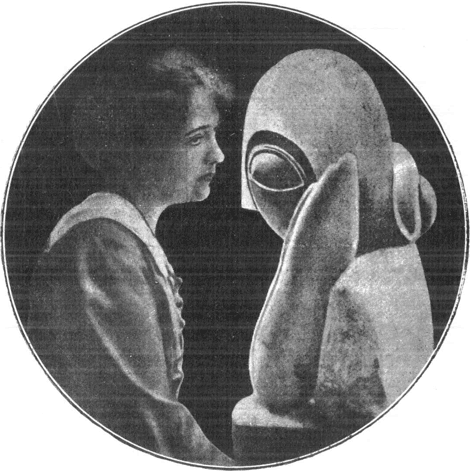Brancusi.
In 1918, in het laatste nummer van den eersten jaargang (1917-18) publiceerde ‘De Stijl’ een plastiek ven den roemeenschen beeldhouwer Brancusi, ‘Portret van Mme Poganey’ en wel als voorbeeld van zuivere plastiek, tegenover een onzuiver en ongeniaal product 't welk eveneens voor plastiek doorging.
V. Huszar wees in een klaar artikel op het enorme onderscheid tusschen deze twee. Sinds 1917 heeft Brancusi in tegenstelling tot Archipenko (die in Amerika in naturalistische decadence, nauw verwant aan wat we met ‘Kitsch’ kunnen betitelen, ten onderging) en Vantongerloo (die zich in potterie en wetenschappelijk beuzelwerk verloor) heeft Brancusi zich tot de uiterste consequentie, tot de meest elementaire plastiek, die in Europa ontwikkeld werd, doorgezet. Zijn prachtige natuur behoedde dezen elementarist voor elk compromis. Het is mij een vreugde den genialen kunstenaar hier een ruime plaats in te ruimen.
Nog iets: de stupiede amerikanen ruimden, ter gelegenheid van Branc isi's groote expositie in New-York in 1926 eveneens een groote en nog grooteren plaats in, niet om hem te vieren, doch om hem belachelijk te maken.
Daar men Brancusi niet voor een kunstenaar, doch voor een importeur van materiaal (marmer, koper, brons nikkel en andere materialen, waarin diens werk is uitgevoerd) hield, verlangde men van hem, bewijzen van zijn kunstenaarschap in den vorm van adviezen, diploma's enz. Deze fatale Businees mentaliteit, heeft geen tijd zich in iets anders te verdiepen dan in dollarspeculaties en electrische zetels. We doen hier een greep uit de vele journalistische zotternijen, door den dagbladpers opgedischt: ‘And the grotesque looking thing which resembled a football with the inner tube peeking out through a couple of slits that was a marble portrait bust of Mme Pogany, said to be the wife of the distinguished New-York artist. The custom House officers looked at each other and smiled and one of them remarked: “Well, if any sculptor

made a thing like that and said it looked like my wife, I'd sue him or throw im off the dock”. Whatever the queer looking stuff was, the Custom House inspectors felt very sure it could not be, by any stretch of the imagination, called “art”.
Are Futuriste, cubists, Dadaists and the rest of the freakish bunch really insane? The opinion of some well known medical experts is that if they are sincere, they are insane, and that if they are sane, they are not sincere.
“The psychiatrist”, says the Medical Record’, in examining Cubist productions is at once struck with their similarity to the artistic productions of a class with which he is well acquainted - the dementia praecox group of the insane.